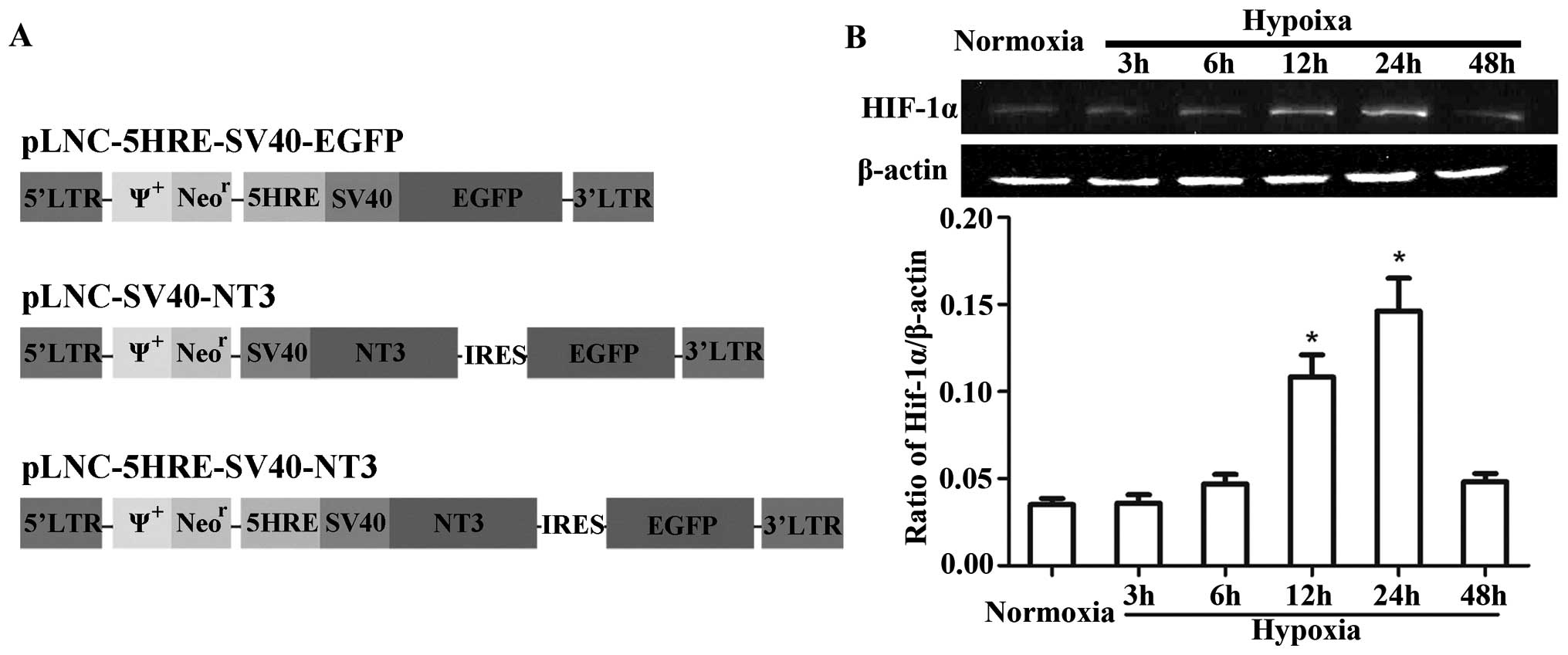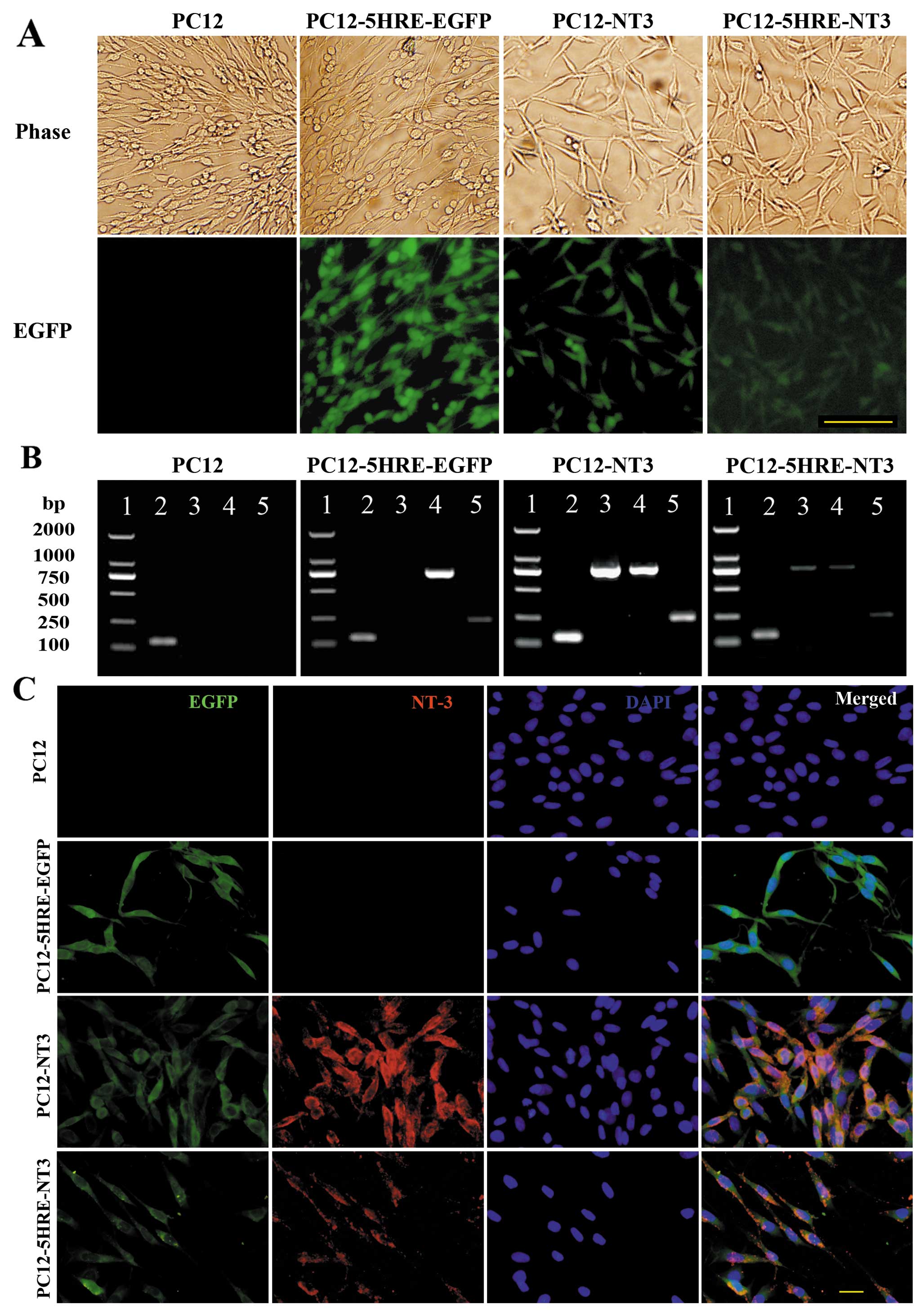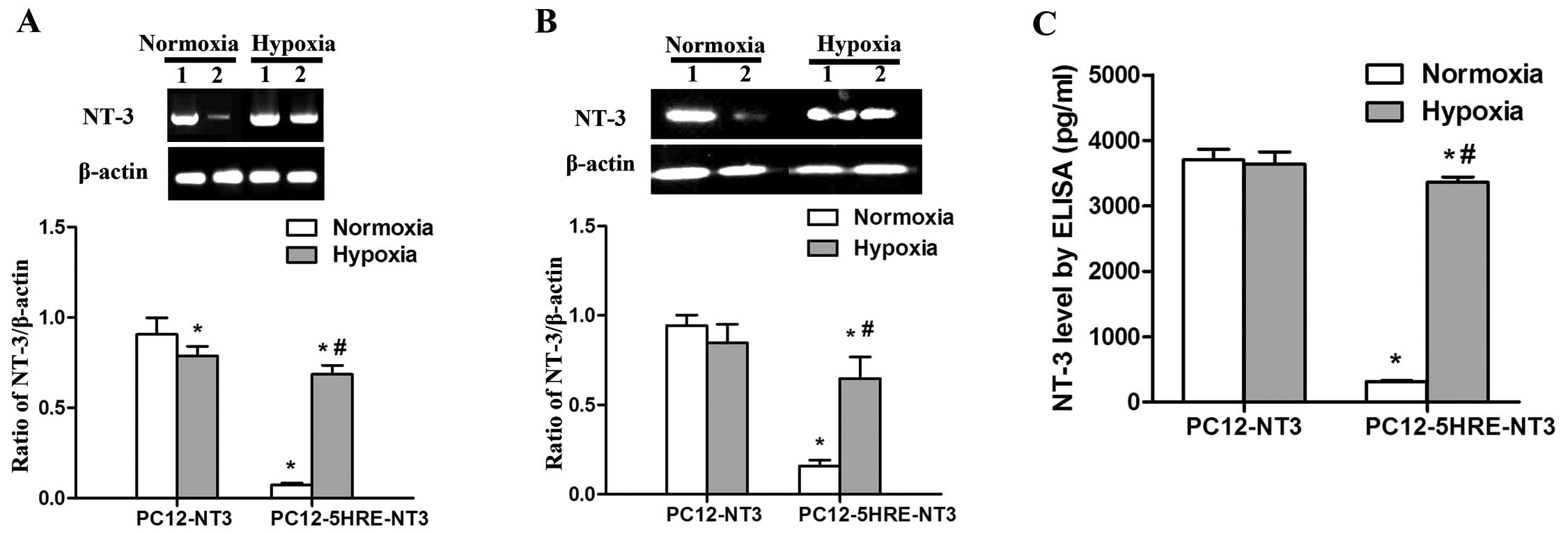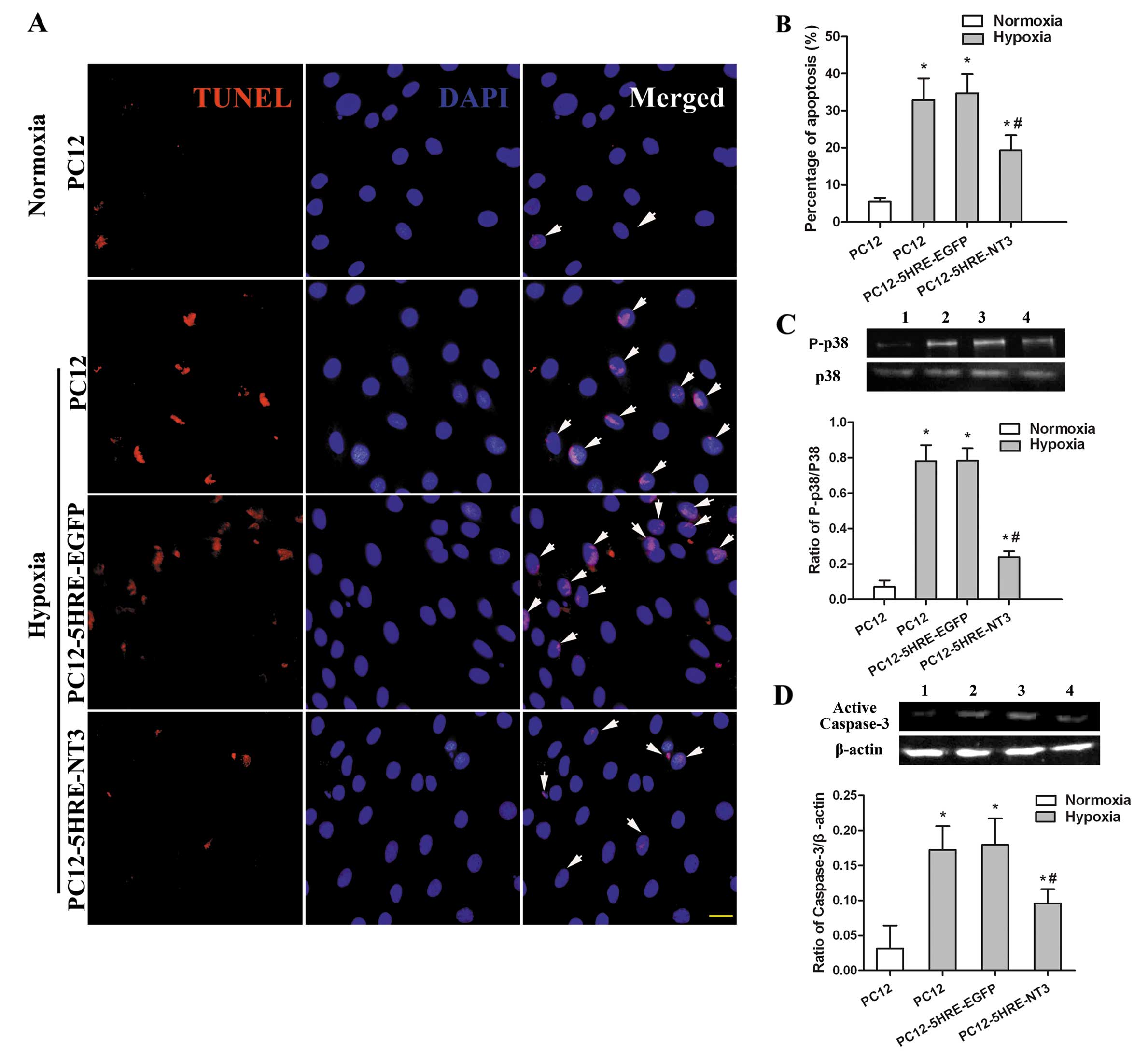Hypoxia-regulated neurotrophin-3 expression by multicopy hypoxia response elements reduces apoptosis in PC12 cells
- Authors:
- Published online on: September 6, 2012 https://doi.org/10.3892/ijmm.2012.1119
- Pages: 1173-1179
Abstract
Introduction
To achieve the optimal effects of gene therapy, it is crucial to develop a strategy to conditionally express the therapeutic gene of interest and reduce any unexpected side-effects resulting from excessive expression of the exogenous gene (1,2). Previous studies have suggested that multiple copies of the hypoxia response element (HRE) can regulate the expression of therapeutic genes in response to hypoxia (3–6). The hypoxia inducible factor-1 (HIF-1) is a transcription factor that plays a key role in the regulation of gene expression under hypoxic conditions (7). HIF-1 is composed of 2 subunits, HIF-1α and HIF-1β. Under normoxic conditions, HIF-1α is rapidly degraded by the ubiquitin-proteasome pathway. However, under hypoxic conditions, HIF-1α becomes stabilized and forms an active HIF-1 heterodimer with HIF-1β. Through its binding to the HRE located in the regulatory domain of target genes, HIF-1α can upregulate the expression of several hypoxia-related genes in response to hypoxia (8). Thus, HRE can regulate downstream gene expression according to the activity of HIF-1, which is affected by the oxygen concentration.
Neurotrophin-3 (NT-3) not only activates its own specific orphan receptor, TrkC, but also activates TrkA and TrkB to mediate almost all of its neuron survival and differentiation-promoting activities in the central and peripheral nervous system (9). In vitro, exogenous NT-3 promotes the proliferation and survival of neural stem cells and increases the percentage of neural stem cells that differentiate into neurons (10–12). In vivo, NT-3 facilitates angiogenesis and neurogenesis by which functional recovery can be promoted after stroke (13–15). These results suggest that NT-3 may be an optimal gene to promote neuroprotection against a number of brain injuries including cerebral ischemia.
In the present study, we generated a recombinant retroviral vector expressing NT-3 under the control of a cassette constructed by 5 copies of the HRE and the simian virus 40 minimal promoter (5HRE-SV40mp). The hypoxia-regulated NT-3 expression was confirmed, and the protective effects of hypoxia-regulated NT-3 against apoptosis were demonstrated in PC12 cells. Moreover, the activities of p38 and caspase-3, which may be involved in these effects, were investigated.
Materials and methods
Cell culture and hypoxia treatment
PT67 cells (American Type Culture Collection) were cultured in DMEM (Gibco) supplemented with 10% fetal bovine serum (Gibco), 100 U/ml penicillin and 100 U/ml streptomycin (Sigma) at 37°C in a humidified incubator containing 95% air and 5% CO2. PC12 cells were maintained in DMEM supplemented with 10% horse serum (HyClone), 5% fetal bovine serum, 100 U/ml penicillin and 100 U/ml streptomycin. For immunocytochemistry and in situ cell death detection, the cells were plated onto poly-L-lysine-coated coverslips.
On day 2 after plating, the cells were placed in an anaerobic workstation (Bugbox; Ruskinn Technology) and perfused with a gas mixture of 5% CO2, 0.3% O2 and 94.7% N2 to induce hypoxia. For HIF-1α detection, the cells were exposed to hypoxia for 3, 6, 12, 24 and 48 h. For hypoxia-regulated NT-3 expression experiments and the apoptosis assay, the cells were exposed to hypoxia for 48 h.
Construction of recombinant retroviral vector
The full length coding sequences of human NT-3, 5 copies of the vascular endothelial growth factor (VEGF) HRE consensus sequence (CCACAGTGCATACGTGGGCTCCAACAGGTCCTCTT), SV40mp and enhanced green fluorescent protein (EGFP) were cloned into the retroviral vector, pLNCX (Clontech), between 2 long terminal repeats to generate pLNC-5HRE-SV40-EGFP, pLNC-SV40-NT3 and pLNC-5HRE-SV40-NT3 (Fig. 1A).
Generation of transgenic PC12 cells
To generate retroviruses that can mediate 5HRE-EGFP, NT-3 or 5HRE-NT3 gene transfer, the PT67 packaging cells were transfected with the constructed plasmids using Lipofectamine 2000 (Invitrogen). After 2 days, the virus-containing supernatants were filtered through a 0.45-μm cellulose acetate filter and added to PC12 cells (American Type Culture Collection) for 24 h. The medium was then replaced with DMEM containing 10% horse serum and 5% fetal bovine serum. After 24 h, G418 (Invitrogen) was added to the medium to screen and select for individual colonies. The colonies were identified using reverse transcription PCR (RT-PCR), immunocytochemistry and western blot analysis. The transgenic PC12 cells were designated as PC12-5HRE-EGFP, PC12-NT3 and PC12-5HRE-NT3.
RT-PCR
Total RNA was isolated from cells using the TRIzol LS reagent (Invitrogen), and first-strand cDNA was synthetized using the PrimeScript™ RT reagent kit (Takara Bio, Inc.). PCR reactions were performed using the Premix Taq Version 2.0 (Takara Bio, Inc.). To detect the exogenous genes, β-actin mRNA was used as the internal control and the following primers were used: β-actin, 5′-GGAGATTACTGCCCTGGCTCCTA-3′ (forward) and 5′-GACTCATCGTACTCCTGCTTGCTG-3′ (reverse); SV40mp, 5′-CGGGATCCGTTAACTCTGCGATCTGC-3′ (forward) and 5′-CGGTGAAGATCTCT GCAGAATTCGAAGC-3′ (reverse); NT-3, 5′-GGCAGATCTGGTGATGTCCATCTTG-3′ (forward) and 5′-GCCGAGCTCTCATGTTCTTCCGATT-3′ (reverse); and EGFP, 5′-CGGGATCCAGATCTCGCCACCATG-3′ (forward) and 5′-CCATCGATGGTTACTTGTACAGCTCGTCC-3′ (reverse). The reactions were performed in a total volume of 20 μl with an initial cycle at 94°C for 2 min, followed by 30 cycles as follows: 94°C for 30 sec, 60°C for 30 sec and 72°C for 1 min. The amplified PCR products were separated on 1.5% agarose gels and subsequently imaged. For a semiquantitative analysis of NT-3 mRNA, the band intensities were measured using the ImageJ software (version 1.43u, National Institutes of Health), and the data were normalized to the level of β-actin in the same sample.
Immunocytochemistry
The cells were fixed with 4% paraformaldehyde for 20 min, blocked with 5% normal goat serum for 1 h and labeled with rabbit monoclonal anti-NT-3 primary antibody (1:100; Santa Cruz Biotechnology, Inc.) and Cy3-conjugated goat anti-rabbit IgG secondary antibody (1:500; Vector Laboratories). After counterstaining with DAPI (Sigma), the cells were imaged using a fluorescence microscope (Olympus BX51).
Western blot analysis
The cells were harvested and lysed in RIPA lysis buffer (Pierce Biotechnology, Inc.) supplemented with a protease inhibitor cocktail (Roche Diagnostics). The lysate was centrifuged at 12,000 rpm for 10 min at 4°C, and the protein concentration of the supernatant was determined using a BCA protein assay kit (Pierce Biotechnology, Inc.). Equal amounts of protein from each lysate were separated using 12% SDS-PAGE, and transferred onto a nitrocellulose membrane. The membrane was blocked with 5% non-fat milk in TBS-T (50 mM Tris, 150 mM NaCl, pH 7.6, 0.1% Tween-20) for 4 h. The following primary antibodies were incubated with the membrane overnight at 4°C: mouse monoclonal anti-HIF-1α (1:2000; Abcam), rabbit monoclonal anti-NT-3 (1:200, Santa Cruz Biotechnology, Inc.), rabbit polyclonal anti-active caspase-3 (1:1000; Abcam), rabbit monoclonal anti-P-p38 (1:1000; Cell Signaling Technology, Inc.), rabbit monoclonal anti-p38 (1:2000; Cell Signaling Technology, Inc.) and mouse monoclonal anti-β-actin (1:5000; Santa Cruz Biotechnology, Inc.). The immunoreactive bands were visualized by enhanced chemiluminescence (Pierce Biotechnology, Inc.) using a horseradish peroxidase-labeled secondary anti-rabbit/mouse antibody (1:2000; Santa Cruz Biotechnology, Inc.).
Enzyme-linked immunosorbent assay (ELISA)
The cells were incubated for 48 h under normoxic or hypoxic conditions. The NT-3 levels in the PC12-NT3 and PC12-5HRE-NT3-conditioned medium were determined using an ELISA kit for human NT-3 (Promega) according to the manufacturer’s instructions.
In situ cell death detection
Terminal dUTP nick end-labeling (TUNEL) assay was performed to determine apoptosis using an In situ Cell Death Detection kit (Roche Diagnostics). The cells were fixed with 4% paraformaldehyde for 1 h, permeabilized with 0.1% Triton X-100 in 0.1% sodium citrate for 2 min on ice, incubated with 50 μl TUNEL reaction mixtures for 1 h at 37°C and counterstained with DAPI (Sigma) for 5 min. Three microscopic fields (x20 magnification) of TUNEL-positive cells on 3 separate coverslips were selected and imaged. The number of TUNEL-positive cells was then counted and normalized to the total number of cells in the images captured from these areas. The percentage of positive cells was calculated as the mean of the percentages obtained from 9 images.
Statistical analysis
The data are presented as the means ± SD, and the statistical analysis was performed using ANOVA followed by Fisher’s least significant difference test. A probability value of <0.05 was considered statistically significant.
Results
Detection of HIF-1α expression after hypoxic treatment in PC12 cells
Western blot analyses showed that HIF-1α was expressed at low levels under normoxic conditions and increased after hypoxic treatment in PC12 cells (Fig. 1B). Although HIF-1α expression had not significantly increased after hypoxic treatment in the 3- or 6-h groups, compared with the normoxic group, it did significantly increase after hypoxia in the 12- and 24-h groups (P<0.05), and peaked at 24 h. These data demonstrate the feasibility of using HRE to regulate NT-3 expression in response to hypoxia.
Identification of transgenic PC12 cells
In this study, we successfully constructed recombinant retroviral vectors and generated transgenic PC12 cells. By combining fluorescence with light microphotographs (Fig. 2A), we revealed that all of the transgenic cells were EGFP-positive, whereas no EGFP was detected in the PC12 cells without gene transfer. The RT-PCR results (Fig. 2B) showed mRNA expression of SV40mp and EGFP in all of the transgenic cells, and NT-3 mRNA expression was detected in the PC12-NT3 and PC12-5HRE-NT3 cells but not in the PC12-5HRE-EGFP or PC12 cells without gene transfer. Immunocytochemistry demonstrated that NT-3 and EGFP were co-labeled in PC12-NT3 and PC12-5HRE-NT3 cells, but no NT-3-positive staining could be detected in PC12-5HRE-EGFP or PC12 cells without gene transfer (Fig. 2C), which was consistent with our RT-PCR results.
Verification of hypoxia-regulated NT-3 expression in PC12-5HRE-NT3 cells
To determine whether 5 copies of HRE can conditionally control NT-3 gene expression, we performed RT-PCR, western blot analysis and an ELISA assay to examine the mRNA and protein expression of NT-3. Under normoxic conditions, a very low level of NT-3 mRNA expression was observed in PC12-5HRE-NT3 cells, and this level was significantly lower than that in the PC12-NT3 group (P<0.05) (Fig. 3A). However, NT-3 mRNA expression was significantly increased in PC12-5HRE-NT3 cells after hypoxic treatment compared with the normoxic group (P<0.05). By contrast, NT-3 mRNA expression was decreased in PC12-NT3 cells after hypoxic treatment compared with the normoxic group (P<0.05). The western blot analysis results (Fig. 3B) revealed that the NT-3 protein was also expressed at an extremely low level in PC12-5HRE-NT3 cells, which was significantly lower than that in the PC12-NT3 group under normoxic conditions (P<0.05). After hypoxic treatment, NT-3 protein expression was significantly increased in PC12-5HRE-NT3 cells compared with the normoxic group (P<0.05). We found no significant difference in the level of NT-3 protein expression between the normoxic and hypoxic group in PC12-NT3 cells.
As a secreted protein, NT-3 can be detected in conditional medium with the use of an ELISA assay (Fig. 3C). Our results showed that the NT-3 protein in PC12-5HRE-NT3 cells was detected at 315.79±10.94 pg/ml, which was significantly lower than the level in PC12-NT3 cells (3702.28±163.48, P<0.05) under normoxic conditions. Following hypoxic treatment, NT-3 protein expression significantly increased to a high level of 3361.26±77.86 pg/ml, which was approximately 10-fold greater than that in the normoxic group (P<0.05). Taken together, these data suggest that NT-3 expression was effectively increased by 5HRE in PC12-5HRE-NT3 cells in response to hypoxia.
Reduced apoptosis in 5HRE-NT3 transgenic PC12 cells after hypoxia
Although only a few cells were TUNEL-positive under normoxic conditions (Fig. 4A and B), the percentage of TUNEL-positive cells had significantly increased after 48 h of hypoxic treatment in the PC12 cell group (P<0.05). However, the percentage of TUNEL-positive cells in the PC12-5HRE-NT3 group was significantly reduced compared to the PC12 cell group under hypoxic conditions (P<0.05), whereas the percentage of TUNEL-positive cells was not significantly different between the PC12-5HRE-EGFP and PC12 groups under hypoxic conditions.
Suppressed activation of p38 and caspase-3 is accompanied with a decrease in PC12 cell apoptosis
The phosphorylation of p38 and activation of caspase-3 were detected by western blot analysis to determine whether these proteins were involved in the reduction of apoptosis mediated by gene transfer in PC12 cells. Compared with the PC12 cells in the normoxic group, the phosphorylation of p38 (P<0.05) (Fig. 4C) and activation of caspase-3 (P<0.05) (Fig. 4D) were significantly increased in PC12 cells after 48 h of hypoxia. However, the phosphorylation of p38 and activation of caspase-3 were remarkably decreased in the PC12-5HRE-NT3 group compared with the PC12 cells under hypoxic conditions (P<0.05). There was no significant difference in the phosphorylation of p38 and the activation of caspase-3 between the PC12-5HRE-EGFP and PC12 cell groups under hypoxic conditions. These data indicate that both p38 and caspase-3 may participate in the protective effects of 5HRE-NT3 gene transfer against apoptosis induced by hypoxia in PC12 cells.
Discussion
Hypoxia-specific regulatory systems have been developed to regulate transgene expression in hypoxic tissues (3–8), in which gene expression is upregulated in a tissue-specific manner and reduced in normal tissues. Various copies of HRE have been developed to control therapeutic gene expression and all of these copies of HRE can upregulate the expression of downstream genes in response to hypoxia. Some studies have demonstrated that 5 copies of HRE derived from the human VEGF gene were optimal to mediate response to hypoxia (5,16). However, other studies have found that 9 copies of the HRE from the human EPO gene were more effective than 3 or 6 copies (17). This discrepancy may be attributed to the different promoters used (6,18). There are 2 main promoters used in hypoxia-specific regulatory systems, the minimal cytomegalovirus promoter (CMVmp) and SV40mp. Taking into account the results from our previous study (3), we selected 5 copies of the HRE from the human VEGF gene and SV40mp to construct a cassette to conditionally regulate NT-3 expression in response to hypoxia in this study. As expected, under the control of 5HRE, both the mRNA and protein expression of NT-3 significantly increased after hypoxia in PC12-5HRE-NT3 cells. An ELISA analysis revealed that the concentration of NT-3 protein in the conditioned medium of PC12-5HRE-NT3 cells in the hypoxic group increased by almost 10-fold compared to the normoxic group. These findings indicate that the cassette composed of 5HRE and SV40mp is an available ‘modulator’ to regulate therapeutic gene expression in hypoxia-related diseases.
Different copies of HRE can decrease the basal promoter activity under normoxic conditions. As shown in a previous study, the 5HRE-3NRSE regulator cassette decreased the basal CMVmp activity by approximately 50–97% in comparison with that of the CMV construct in cultured cells under normoxic conditions (19). Moreover, almost no humanized Renilla GFP (hrGFP) expression occurred in the PC12 cells infected by Ad-5HRE-hrGFP under normoxic conditions (20). In vivo, Shen et al (4) found that the lacZ gene was not expressed in the normal areas of the AAVH9-lacZ-transduced mouse brain. Consistent with these data, we found that under normoxic conditions, the 5HRE-SV40mp construct had a significantly lower promoter activity compared with the SV40mp construct, as the basal SV40mp promoter activity was reduced by 92% from NT-3 mRNA expression, 83% from NT-3 protein expression and 91% from secreted NT-3 protein expression. Taken together, these data indicate that 5HRE is an ideal enhancer to perform hypoxia-specific gene expression. Therefore, 5HRE can effectively upregulate downstream gene expression under hypoxic conditions and only small or unexpected side-effects on the physiological process occur through suppression of the promoter under normal conditions.
The PC12 cell line has been extensively used as a model for the study of neurosecretion, neuronal signaling pathways, neuronal differentiation, neuroprotective effects of neurotrophin and ischemic tolerance (21). A number of studies have demonstrated that NT-3 exerts various effects on PC12 cells that have been subjected to various types of treatment, including hypoxia (21). Therefore, the PC12 cell line, which possesses neuron-like properties, is an ideal cell line to use to determine the effects of NT-3 and the bioactive functions of conditionally expressed NT-3.
Hypoxic injury in the PC12 cell model was induced with treatment at an oxygen concentration of 0.3% to mimic cerebral ischemic injury (22). Although HIF-1α expression increased and peaked after hypoxia at 24 h in PC12 cells, the expression of downstream genes was induced in a time-dependent manner (20). Therefore, hypoxia for 48 h was used as a model of hypoxia-induced injury in PC12 cells, in which clear apoptotic responses could be induced and hypoxia-regulated NT-3 expression could be thoroughly induced to display the protective effects against apoptosis.
Caspase-3 plays a critical role in apoptotic execution (23) and hypoxia induces the cleavage of caspase-3 through the p38/mitogen-activated protein kinase (MAPK)-dependent pathway (24). It has previously been reported that NT-3 can promote extracellular signal-regulated protein kinase/MAPK and phosphatidylinositol 3-kinase/Akt phosphorylation, where NT-3 can exert its anti-apoptotic effects (25). In the present study, the decreased activation of p38 and caspase-3 in the PC12-5HRE-NT3 cell group under hypoxic conditions indicated that both p38 and caspase-3 were involved in the reduction of apoptosis induced by hypoxia in PC12 cells, which was mediated by 5HRE-NT3 gene transfer.
In conclusion, in this study, we successfully constructed a retroviral vector carrying 5HRE-NT3 and transferred it into PC12 cells (PC12-5HRE-NT3). Under hypoxic conditions, NT-3 expression was significantly upregulated by 5HRE in PC12-5HRE-NT3 cells. Conditionally expressed NT-3 reduced apoptosis induced by hypoxia in PC12 cells, which may be due to the depressed activation of p38 and caspase-3. These results suggest that the 5HRE-NT3 vector may be useful for the therapy of ischemic diseases, while avoiding side-effects.
Acknowledgements
This study was supported by the National Natural Science Foundation of China (Grant no. 81070998) and a fund from the State Key Laboratory of Medical Neurobiology, Shanghai (no. 10-03). The authors would like to thank Professors Julie Y.H. Chan and Samuel H.H. Chan from the Center for Translational Research in Biomedical Sciences, Chang Gung Memorial Hospital-Kaohsiung Medical Center, Taiwan for their invaluable comments and editorial support.













